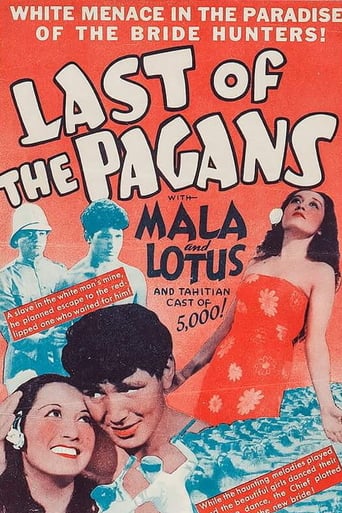

Although it has its amusing moments, in eneral the plot does not convince.
... View MoreThe film was still a fun one that will make you laugh and have you leaving the theater feeling like you just stole something valuable and got away with it.
... View MoreIf the ambition is to provide two hours of instantly forgettable, popcorn-munching escapism, it succeeds.
... View MoreThis movie was so-so. It had it's moments, but wasn't the greatest.
... View MoreI have a sort of on-the-fence feel about this film. I know this is a result of its time, including clichés of the Polynesian people that you have to take with a grain of salt. The 1930s were not exactly a time period of embracing diversity and fighting against racism. It also includes certain tropes of adventure movies that are sexist, such as the main male character Taro kidnapping his bride Lilleo from another island because "that's what his tribe does". Followed by her falling in love with him through what is basically Stockholm Syndrome. That being said, this is one of the few early Hollywood movies I have ever seen which tried to show the abomination of enslaving a group of people. It doesn't do it well, but it gets a C for effort. The film shows everything through the eyes of Taro and the other Polynesians. You see their lives and hear their language (which was probably a Hollywood, bastardized version of a Polynesian language- I'm not entirely sure). They are simply people living out their daily lives, although their daily lives are made out a little like a travel brochure. You see the way the islanders are tricked by by the mining company and then worked to exhaustion. Despite the cheesy romance and rather slapped together ending, this has the underlying message of the cruelty of stealing another person's life for greed. Overall, it is still tame in comparison to history. Also, I understand this is credited as being, in part, based on Herman Melville's Typee, but I really didn't see many similarities except for a few of the customs of the islanders. All in all, it is a beautifully photographed movie and deserves some recognition for it's attempt to be different in its storytelling.
... View MoreDated (meaning racist) tale of love among the island people of the South Seas. Two young lovers are separated by slavers when the man is taken away and forced to work in a mining camp. Shot on location in Tahiti, the visual elements of the film are the most appealing aspect of the movie. The characters are paper thin and situations are awfully contrived, though an underwater fight with a shark and some other disaster sequences are pretty exciting for a film shot in 1935. Loosely based upon Melville's "Typee," this film is hardly a classic, but it's entertaining enough.
... View MoreI recently had the opportunity of viewing this film. It is in black and white and was made quite some time back, but is well worth seeing.Concerning French Polynesia, much of the dialogue is non-English, and the translations are a bit scarce; but not needed much--the actions of the characters and what happens to them tells the story quite adequately.The native men from one island go to another island to steal wives for themselves. The main male character, Taro, kidnaps a woman he especially fancies. She is very unhappy about this--and I fully expected him to drag her back to his island and immediately start raping her, but that is not how it happens. Instead, once he gets there, he courts her-and she begins to become quite taken with his charms.However, there are white men looking for labor for their mines, and the chief in Taro's village is also taken with the woman Taro wants. You can be sure these things come to plenty of troubles for both Taro and his intended.This film was quite different from any I have ever seen before. It was excellently done and well told and I would certainly recommend it.
... View MoreLast of the Pagans features some quite stunning black and white photography by Clyde De Vinna and a paper thin story designed to please those who like travelogues with a touch of romance. Shot on location in Tahiti, the film is a lightweight take on the Robert Flaherty oeuvre, with numerous tips of the hat to the great documentarist's features, especially his 1926 South Seas epic Moana. Mala--an Alaskan native discovered by director W.S. Van Dyke during production of the similar Eskimo (1933)--plays Taro, the male chauvinist pig who steals beautiful Lotus Long from her native village and claims her as his own. Last of the Pagans is a relentless parade of cultural imperialism and cliches about primitive peoples and noble savages, but it looks absolutely gorgeous. You're best advised to turn the sound down, ignore the subtitles, and soak up De Vinna's superb camera work.
... View More